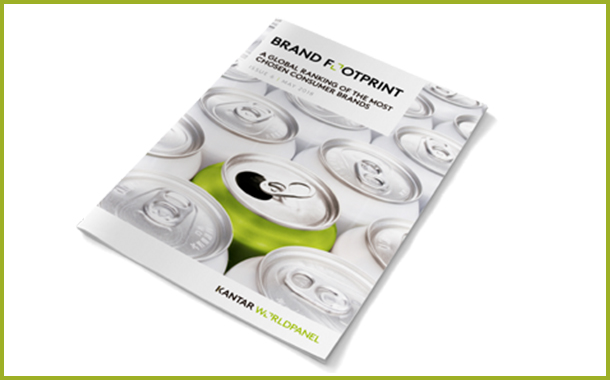Coca-Cola is the world’s most chosen consumer brand for the sixth year running according to the 2018 edition of Kantar Worldpanel’s Brand Footprint report
Sixteen other brands have been chosen more than one billion times in a year by consumers globally
Key facts
- Coca-Cola remains the world’s most chosen brand—for the sixth year running
- Colgate is the second most chosen brand in the ranking and is the only brand chosen by more than half of the global population—with 62% penetration globally
- Maggi is the fastest-growing Top 50 brand with a global presence—with 14% growth in Consumer Reach Points (CRPs)
- Local brands continued to steal share in 2017, taking 64.6% of all brand spend, versus global brands’ 35.4% share with every 0.1% gained now worth $500 million
According to the 2018 edition of Kantar Worldpanel’s Brand Footprint report, there are 17 FMCG brands that are chosen by consumers more than one billion times a year globally. The Brand Footprint rankings measure which brands are being bought by the most consumers the most often. Coca-Cola is the world’s most chosen brand, picked from the shelves 5.8 bn times in a year. Colgate and Maggi both achieve podium positions, being also the world’s most chosen personal care and food brands. Colgate is the only brand chosen by more than half of the global population—with 62% penetration globally1. Maggi is the fastest-growing Top 50 brand with a global presence—with 14% growth in Consumer Reach Points (CRPs)2, which has helped the brand to rise one position to become third in the ranking this year.
Six out of the 17 brands chosen more than one billion times in a year are owned by Unilever, which leads the manufacturers ranking with 36 bn CRPs per year. Unilever’s portfolio includes Lifebuoy in 4th position and Sunsilk and Knorr among the Top 10. Dove, Lux and Sunlight are also Unilever’s brands in the billionaire club. Two Pepsico brands, Lay’s and Pepsi, jointly with Nescafé and Indomie – Indofood’s very successful brand in Asia and Africa – made the remaining positions in the Top 10. Nestlé, P&G’s Downy, Palmolive and Sprite are the other brands that join this year the exclusive club of global brands chosen by consumers more than one billion times annually.
Table 1. The 17 billionaire brands in the global FMCG brands ranking revealed by the Brand Footprint report.
| Rank | Brand | Penetration (%) | Consumer choice (choices by shopper) | Consumer reach points (m) |
| 1 | Coca-Cola | 41.3% | 12.7 | 5817 |
| 2 | Colgate | 61.6% | 5.7 | 3886 |
| 3 | Maggi | 30.4% | 7.4 | 2489 |
| 4 | Lifebuoy | 27.5% | 7.8 | 2375 |
| 5 | Lay’s | 29.1% | 6.4 | 2073 |
| 6 | Pepsi | 22.7% | 7.8 | 1971 |
| 7 | Nescafé | 22.3% | 7.9 | 1955 |
| 8 | Indomie | 4.7% | 34.9 | 1817 |
| 9 | Sunsilk/Sedal/Seda | 23.8% | 6.8 | 1799 |
| 10 | Knorr | 27.1% | 5.8 | 1748 |
| 11 | Dove | 36.8% | 4.3 | 1748 |
| 12 | Lux | 32.6% | 4.2 | 1526 |
| 13 | Nestlé | 28.5% | 4.5 | 1439 |
| 14 | Sunlight | 11.4% | 10.4 | 1322 |
| 15 | Downy | 14.2% | 8.2 | 1290 |
| 16 | Palmolive | 16.2% | 6.1 | 1105 |
| 17 | Sprite | 24.8% | 3.8 | 1040 |
Source: Kantar Worldpanel’s Brand Footprint Report

Josep Montserrat, CEO Kantar Worldpanel, explained, “A lot has been said about the FMCG market being more challenging in recent times, and despite all this, 22 among the Top 50 global brands managed to be chosen by consumers more times in the last 12 months. Growth opportunities are there to be taken, and brands will need to dive deeper to find them because they may not be in the old well-known spots. Our data shows that out-of-home and growing channels such as e-commerce, discounters, cash and carrie outlets and convenience stores are growing faster than the overall FMCG market and it is time to invest more decisively in what consumers are asking for.”
Local brands and global brands
The study also shows that local brands grew in 2017, taking 64.6% of all brand spend, versus global brands’ 35.4% share, with every 0.1% gained now worth $500 million. This highlights the continued march of local brands winning share from the global players.
Global brands are stronger but still losing share in the homecare, and beauty and personal care categories, taking 47% and 58.4% of global spend per sector respectively. It was only within the beverages sector that global brands are winning, having gained share from local brands three years in a row (38.3% global versus 61.7% local in 2018, compared to 38.1% global vs. 61.9% local in 2015).
Table 2. Global and local brands market share
| 2016 | 2017 | |||
| Global Brands | Local Brands | Global Brands | Local Brands | |
| Total FMCG | 35.8% | 64.2% | 35.4% | 64.6% |
| Food | 27.1% | 72.9% | 26.6% | 73.4% |
| Drinks | 38.2% | 61.8% | 38.3% | 61.7% |
| Dairy | 20.6% | 79.4% | 20.0% | 80.0% |
| Beauty and Personal Care | 58.8% | 41.2% | 58.4% | 41.6% |
| Homecare | 47.7% | 52.3% | 47.0% | 53.0% |
Source: Kantar Worldpanel’s Brand Footprint Report

















